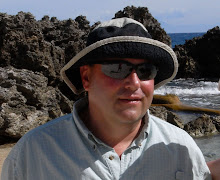
Bailey’s Key (From the RIMS Instructors Guide)
Bailey’s Key, located in the western part of AKR’s property, houses one of RIMS's dolphin enclosures. This key also serves as a wildlife sanctuary for parrots, agoutis, iguanas, and at one time some resident sea turtles. A nature trail encompasses the island and provides access to the west side of the key where you can explore the rocky intertidal zone or snorkel the shallow back reef. The rocky shores on Bailey’s Key are typically vertical with an undercut of approximately 1.5 ft height and a depth of 2 ft. The weathered coral rock is sharp and jagged and must be traversed with care.
The water depth on the west side of the key is shallow becoming 3 to 4 feet deep about 100 ft from shore. It may be necessary to wade out a short distance before snorkeling. Be careful to avoid the aggregations of Rock Boring Urchins (Echinometra lucunter). As you snorkel west of the key you travel over an extensive bed of Turtle Grass (Thallasia testudinum). Scattered through the bed are small boulders of Mustard Hill Coral (Porites asteroides). As you continue further west you will encounter larger boulders of coral and patches of reef and rubble. Take your time and slowly navigate your way around and through the narrow openings. If you reach a dead end, back up and try again. Attempting to snorkel over the boulder heads may result in damage to the fragile coral and other organisms and cuts and abrasions on you.
Lettuce Coral (Agaricia tenuifolia) is the most dominant coral in this area. Finger Coral (Porites porites), Mustard Hill Coral (Porites asteroides), Smooth Brain Coral (Diploria strigosa) and Lobed Star Coral (Montastrea annularis.) are also common. Starlet corals (Siderastrea spp.) are also present along with an occasional Staghorn Coral (Acropora cervicornis). Black Sea Rods (Plexaura homomalla), Corky Sea Fingers (Briareum asbestinum) and sea fans (Gorgonia spp.) are among the more common octocorals observed.
There is also a prevalence of algae at this site likely due to the closer proximity to shore and nutrient rich runoff. Turbinaria spp., Dictyota spp., Halimeda spp. and Stypopodium zonale are algae species found in this area as well as Rhipocephalus phoenix on the sandy bottom. If you carefully lift pieces of the rubble you may find the Spiny Brittle Star (Ophiocoma paucigranulata) or some of the many other brittle star species that thrive in these low light environments. Reef Urchins (Echinometra viridis) can be seen in the cracks and holes between coral and rubble. Variegated Urchins (Lytechinus variegatus), West Indian Sea Eggs (Tripneustes ventricosus) and Donkey Dung Sea Cucumbers (Holothuria mexicana) are among the many other echinoderms encountered in the sandy bottom and sea grass beds.



No comments:
Post a Comment